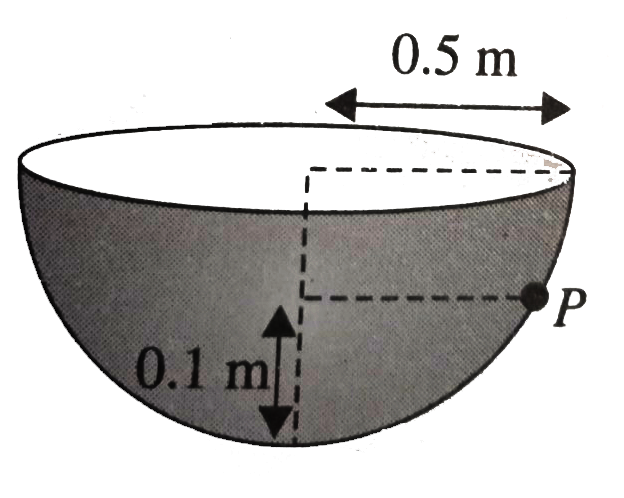A circular disc of radius 'R' is placed co-axially and horizontally inside and opaque hemispherical bowl of radius 'a', Fig. The far edge of the disc is just visible when viewed from the edge of the bowl. The bowl is filled with transparent liquid of refractive index μ and the near edge of the dise becomes just visible. How far below the top of the bowl is the disc placed ?
 .
.
Before the liquid is filled, far edge of disc i.e. A is just visible. Therefore, the direction of the incident ray is AM. In the presence of liquid, the near edge of the disc i.e., B is just visible. Therefore, the direction of the incident ray is BM. In both the cases, the refracted ray will be along MN.
If μ is the refractive index of the transparent liquid in bowl, then
1μ=sinisinr=sinisinα ....(i)
From the figure, in ΔBMP
sini=BPBM=a−R√d2+(a−R)2
andsinα=cos(90∘−α)=APAM=a+R√d2+(a+R)2
Substituting these values in equation (i), we get:
1μ=a−R√d2+(a−R)2×√d2+(a+R)2a+R
⇒μ×(a−R)×√d2+(a+R)2=(a+R)×√d2+(a+R)2
⇒ d=μ(a2−R2)[(a+r)2−μ(a−R)2]1/2
Related Playlists
- BOOK - MODERN PUBLICATIONCHAPTER - RAY OPTICS AND OPTICAL INSTRUMENTSEXERCISE - Higher Order Thinking Skills & Advanced Level (QUESTIONS WITH ANSWERS)20videos
RAY OPTICS AND OPTICAL INSTRUMENTS
- BOOK - MODERN PUBLICATIONCHAPTER - RAY OPTICS AND OPTICAL INSTRUMENTSEXERCISE - Revision Exercises (Very Short Answer Questions)82videos
RAY OPTICS AND OPTICAL INSTRUMENTS
- BOOK - MODERN PUBLICATIONCHAPTER - RAY OPTICS AND OPTICAL INSTRUMENTSEXERCISE - NCERT (EXemplar Problems Obejective Questions) (Multiple Choice Questions (Type-II)6videos
RAY OPTICS AND OPTICAL INSTRUMENTS
- BOOK - MODERN PUBLICATIONCHAPTER - NUCLEIEXERCISE - CHAPTER PRACTICE TEST FOR BOARD EXAMINATION15videos
NUCLEI
- BOOK - MODERN PUBLICATIONCHAPTER - SEMICONDUCTOR ELECTRONICS METERIALS DEVICES AND SIMPLE CIRCUITS EXERCISE - CHAPTER PRACTICE TEST FOR BOARD EXAMINATION12videos
SEMICONDUCTOR ELECTRONICS METERIALS DEVICES AND SIMPLE CIRCUITS
Similar Questions
Find the total surface area of a hemispherical bowl of radius 5cm
View SolutionFind the total surface area of a hemispherical bowl of radius 5 cm .
View SolutionThe coefficient of friction between an insect and a hemispherical bowl of radius r is μ. The maximum height to which the insect can crawl in the bowl is
View SolutionA hemispherical bowl of radius r is placed in uniform electric field E . The electric flux passing through the bowl is
View SolutionIf R and r are the external and the internal radii of a hemispherical bowl, then what is the area of the ring, which forms the edge of the bowl (in sq. units)?
View SolutionA hemispherical bowl of radius unity is filled up with water upto the depth 12. The valume of water in the bowl is
View SolutionA hemispherical bowl of radius unity is filled up with water upto the depth 12. The valume of water in the bowl is
View SolutionA hemispherical bowl is made of steel, 0.25 cm thick. The inner radius of the bowl is5 cm. Find the outer curved surface area of the bowl.
View SolutionThe radius of a hemispherical bowl is 6 cm. The capacity of the bowl is
(Take π=227)View Solution
A small mass of 10 g lies in a hemispherical bowl of radius 0.5 m at a height of 0.1 m from the bottom of the bowl. The mass will be in equilibrius if the bowl rotates at anView Solution


